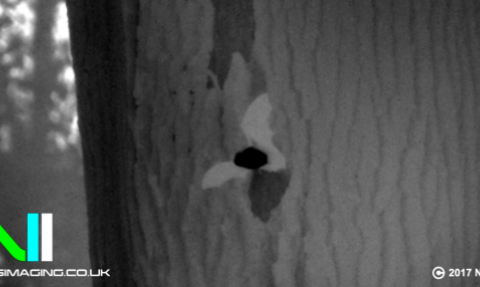
Barbastelle Roost (c) Russell Savory & Nexus Imaging Ltd
Hertfordshire Barbastelle Bat Project
The Hertfordshire Barbastelle Bat Project has been set up in partnership with the Herts and Middlesex Bat Group and aims to increase our knowledge of this incredibly rare bats’ distribution in the county.
The barbastelle bat is classified as a European Protected Species (Annex II) under the Conservation of Habitats and Species Regulations 2017, Near Threatened on the IUCN Red List, protected in the UK under the Wildlife and Countryside Act, 1981, and classified as a Priority Species in the UK Biodiversity Action Plan. The Trust is committed to their conservation and has identified barbastelles as one of seven priority species in the 2016-2021 Strategic Plan.
The project
The project was launched in 2016 with the aim of significantly improving our knowledge of barbastelle distribution. Only one barbastelle maternity colony was known from the county, which had been discovered by HMBG near Bishop’s Stortford in 2012.
The first phase of the project was to target a series of woodlands for survey, selected for their habitat suitability for barbastelle. The next stage was to train HMBG volunteers and to acquire and deploy remote detectors to identify barbastelle activity hotspots for future exploration. To get the project off the ground the Trust and HMBG trained bat surveyors in barbastelle detection and carried out a series of surveys at Tarmac’s Panshanger Park in summer 2016 which recorded some barbastelle activity, but sadly not a maternity colony. During 2017 static detectors were deployed in other woodlands across the county in an attempt to pick up barbastelle activity and build a robust database of records. Grant funding from the Spear Charitable Trust, Christopher Laing Foundation and John Spedan Lewis Foundation enabled HMWT to purchase 4 detectors and 24 bat boxes to hugely increase our capacity to find barbastelle. The surveys resulted in hundreds of new records and gave us a much better idea of where maternity colonies might be.
The success of 2017 initiated the final and most exciting stage of the project. A licence was obtained from Natural England to trap, ring, radio tag and then track barbastelle, so that we could confirm maternity colonies and then find where they forage and roost. This is vital to both find out more about the size of the population and more importantly advise landowners on how they can conserve and enhance the habitat of the bats.
2019
During 2018 we had remote detectors deployed around the county in woodlands which we thought had good potential based on our knowledge of the other two populations we had found. This led us to a promising site near Stevenage. Further surveys over the maternity period revealed that there was a lot of activity that might indicate a maternity roost. So after the main maternity period, but before colony break-up, we arranged a trapping session to see if we could catch and radio tag some bats, so they would lead us to their roosts.
Our trapping was once again extraordinarily successful and we managed to tag 2 bats. These were followed to a total of 5 tree roosts, 4 behind flaking bark and one deep in a tree cavity. Simultaneous counts at these roosts revealed the startling number of 90 bats. This represents one of the largest maternity colonies ever recorded in mainland Britain! Unfortunately, we were less successful in locating foraging areas, which was concerning because of development proposals in the vicinity.
The future
We will continue to search for new maternity populations next year with acoustic detectors but will also revisit the Stevenage population to assess the impact of the woodland work. We may also revisit the other known colonies and use thermal equipment to see if we can locate and monitor more roosts during the pre-maternity and maternity period. Exciting times ahead!
2018
With the kind permission of the National Trust, the Ashridge Estate near Tring was selected as our major focus for 2018. Surveys conducted by HMBG in 2017 had shown that it was highly likely to contain a maternity colony of barbastelle. Beyond our wildest expectations, our mist netting event in August captured 7 barbastelles, 5 post-lactating females and 2 juvenile females. This unequivocally confirmed the presence of only the second ever maternity colony found in Hertfordshire. Two of the bats were duly radio-tagged and have been invaluable in revealing information on the wider colony. The tags remained on the bats for just over a week before they were shed and revealed two distinct foraging territories and 8 roost trees. Emergence counts at these roosts have discovered a minimum population size of 43 bats – although the real population is likely to be much higher than this because the colony will use many more than two roosts each day. The importance of this knowledge and communicating this to the landowner is highlighted by the location and condition of several of the roost trees. These are dead, dying or damaged trees with cracks, splits or peeling bark, next to pathways - just the sort of tree that is routinely removed for health and safety reasons! The information the project generates will help the Estate to tailor its tree work to protect and conserve this vital roosting resource.
The future
Ashridge is the first of a series of barbastelle hotspots that the project has revealed. In months ahead and years to come, each one of these will receive similar attention which we hope will lead to the discovery of more maternity colonies, increased knowledge and better protection for the species. Our thanks go to all the project contributors and partners including Herts and Middx Bat Group, The Ashridge Estate, The National Trust, Project Funders, The Environment Agency, Beds Bat Group, Landowners and all the volunteers who have made the project possible.
